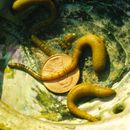Look Alikes
(
Inglês
)
fornecido por Invertebrates of the Salish Sea
How to Distinguish from Similar Species: This is the only local sipunculan with the dark blotches and transverse streaks on its introvert
- licença
- cc-by-nc-sa
- direitos autorais
- Rosario Beach Marine Laboratory
Habitat
(
Inglês
)
fornecido por Invertebrates of the Salish Sea
In gravel under rock, in crevices, in burrows made by boring clams, in roots of surfgrass or kelp holdfasts, mussel beds, among growth on pilings. Open coast and protected water.
- licença
- cc-by-nc-sa
- direitos autorais
- Rosario Beach Marine Laboratory
Habitat
(
Inglês
)
fornecido por Invertebrates of the Salish Sea
Depth Range: Middle to low intertidal, shallow subtidal
- licença
- cc-by-nc-sa
- direitos autorais
- Rosario Beach Marine Laboratory
Comprehensive Description
(
Inglês
)
fornecido por Invertebrates of the Salish Sea
This sipunculan has inconspicuous, fingerlike, unbranched filiform tentacles. The introvert has dark blotches and transverse streaks, with 15-25 rings of small hooks near its anterior end. Trunk color is pale sepia or tan to dark brown, often with brown or purplish spots. Skin is rough due to conical papillae that are largest at the posterior region of the trunk.
- licença
- cc-by-nc-sa
- direitos autorais
- Rosario Beach Marine Laboratory
Comprehensive Description
(
Inglês
)
fornecido por Invertebrates of the Salish Sea
Biology/Natural History: Length to 12 cm. This is the most common sipunculan in California. In the San Juan Islands it breeds from June to September. When gravid, gametes may make up to 37% of animal's mass. The eggs are yellow or orange, about 140 x 110 x 90 microns, flattened and beanlike and surrounded by a thick envelope. The planktotrophic larva spends a long time in the plankton. This species has cerebral eyes which are similar to those of flatworms, annelids, and mollusks. This species uses its 18-24 short, simple tentacles around the mouth to collect detritus from the surface of the sediment, then inverts the introvert and swallows the detritus. Black Oystercatchers are said to eat this species on Vancouver Island. Members of Genus Phascolosoma have their longitudinal muscles in 4 bands rather than in a continuous column around the body as seen in most other Sipunculans. These bands can sometimes be seen externally. Sipunculan coelomic fluid contains unusual motile, multicellular structures called urns. The urns gather metabolic and particulate wastes, produce mucus in response to infection, and help the blood to clot after an injury. The urns can easily be seen in the coelomic fluid under a microscope. Sipunculans such as Phascolosoma have separate sexes. Their eggs or sperm are produced from cells in the peritoneum surrounding the coelom rather than in distinct gonads. They mature in the coelomic space and then are shed out the nephridia. Males spawn first, which seems to trigger females to spawn. The fertilized egg develops into a trochophore larva which feeds off internal food, then elongates and becomes a pelagosphera larva which feeds. The pelagosphera eventually elongates more, settles, and grows up into a juvenile then adult.A recent study has shown that individuals of this species from the Sea of Japan have different developmental characteristics and are quite genetically isolated from those along our coast. Their conclusion was that these individuals from opposite sides of the North Pacific are likely cryptic species. If that is the case, it is likely that Atlantic populations may also be a cryptic species.
- licença
- cc-by-nc-sa
- direitos autorais
- Rosario Beach Marine Laboratory
Distribution
(
Inglês
)
fornecido por Invertebrates of the Salish Sea
Geographical Range: Kodiak Island, Alaska to Bahia de San Quintin, Sea of Japan. It is also found in the Atlantic and Indian Oceans.
- licença
- cc-by-nc-sa
- direitos autorais
- Rosario Beach Marine Laboratory
Phascolosoma (Phascolosoma) agassizii
(
Neerlandês; Flamengo
)
fornecido por wikipedia NL
Phascolosoma (Phascolosoma) agassizii is een soort in de taxonomische indeling van de Sipuncula (Pindawormen).
Het dier behoort tot het geslacht Phascolosoma en behoort tot de familie Phascolosomatidae. De wetenschappelijke naam van de soort werd voor het eerst geldig gepubliceerd in 1866 door Keferstein.[1]
Bronnen, noten en/of referenties Geplaatst op:
19-10-2011
Dit artikel is een beginnetje over biologie. U wordt uitgenodigd om op bewerken te klikken om uw kennis aan dit artikel toe te voegen.

- licença
- cc-by-sa-3.0
- direitos autorais
- Wikipedia-auteurs en -editors

